Mochi is the perfect afternoon snack paired with tea. It’s commonly recognised as a dainty Japanese dessert with various flavours to satiate any sweet tooth. However, it can also become a savoury snack with a few tweaks.
Traditionally, this delectable Asian sweet uses special short-grain rice called mochigome that’s soaked, steamed, and beaten into a dough. It’s shaped into tiny buns and typically filled with something sweet, like red bean paste.
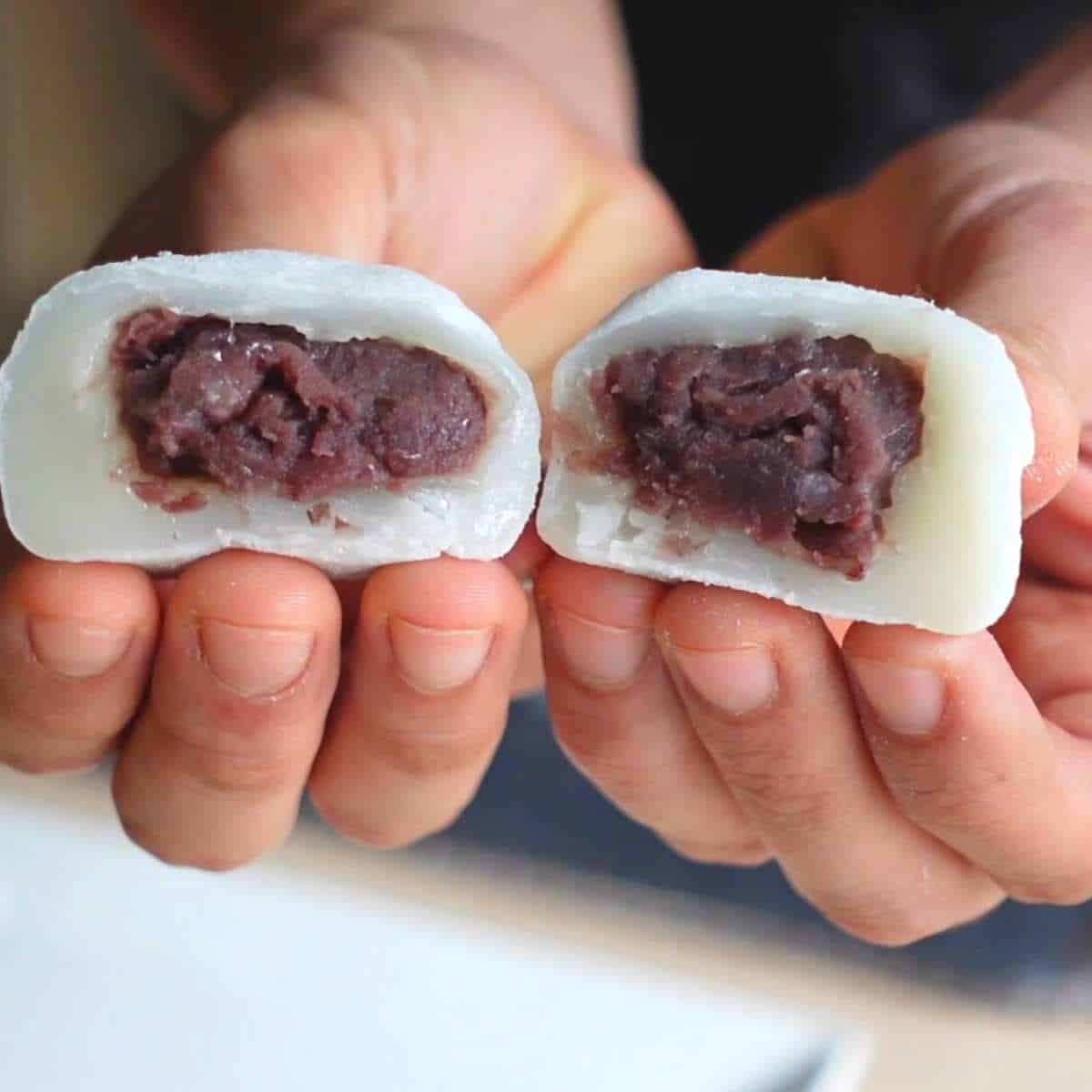
After much experimenting, we discovered that it’s possible to recreate the soft, chewy daifuku mochi texture at home. Thankfully, it's easy to make with a microwave or steamer using some glutinous rice flour.
For those who cannot wait to sink their teeth into this dessert, here's our quick and easy recipe to replicate the taste sensation at home.
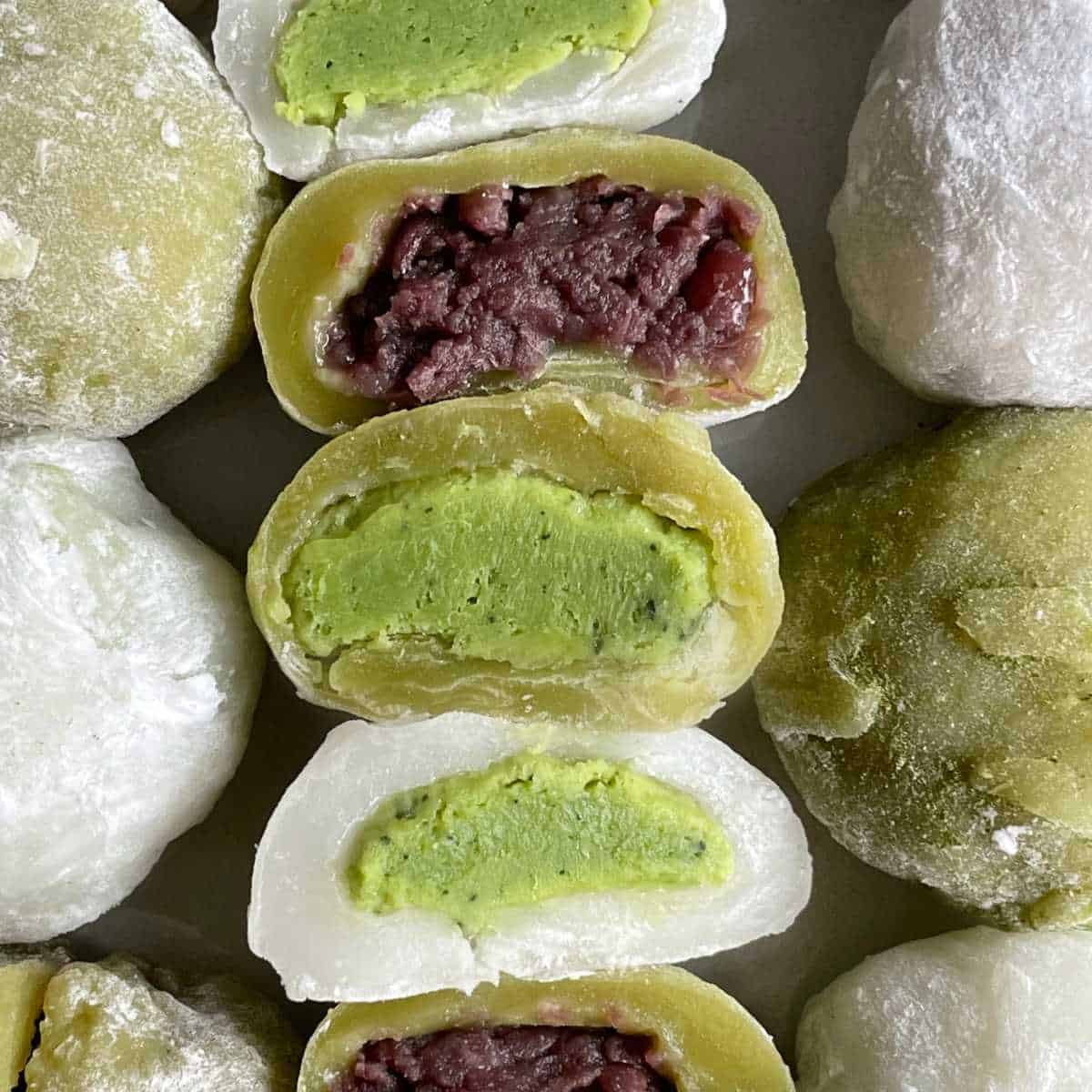
Jump to:
What is mochi?
Traditional mochi is a plain, glutinous rice cake that becomes daifuku when it’s filled with sweet red bean paste. These Japanese daifuku aren't naturally sweet but transform into dessert with the proper filling. Some chefs will add fruits, matcha tea, and even ice cream inside their mochi.
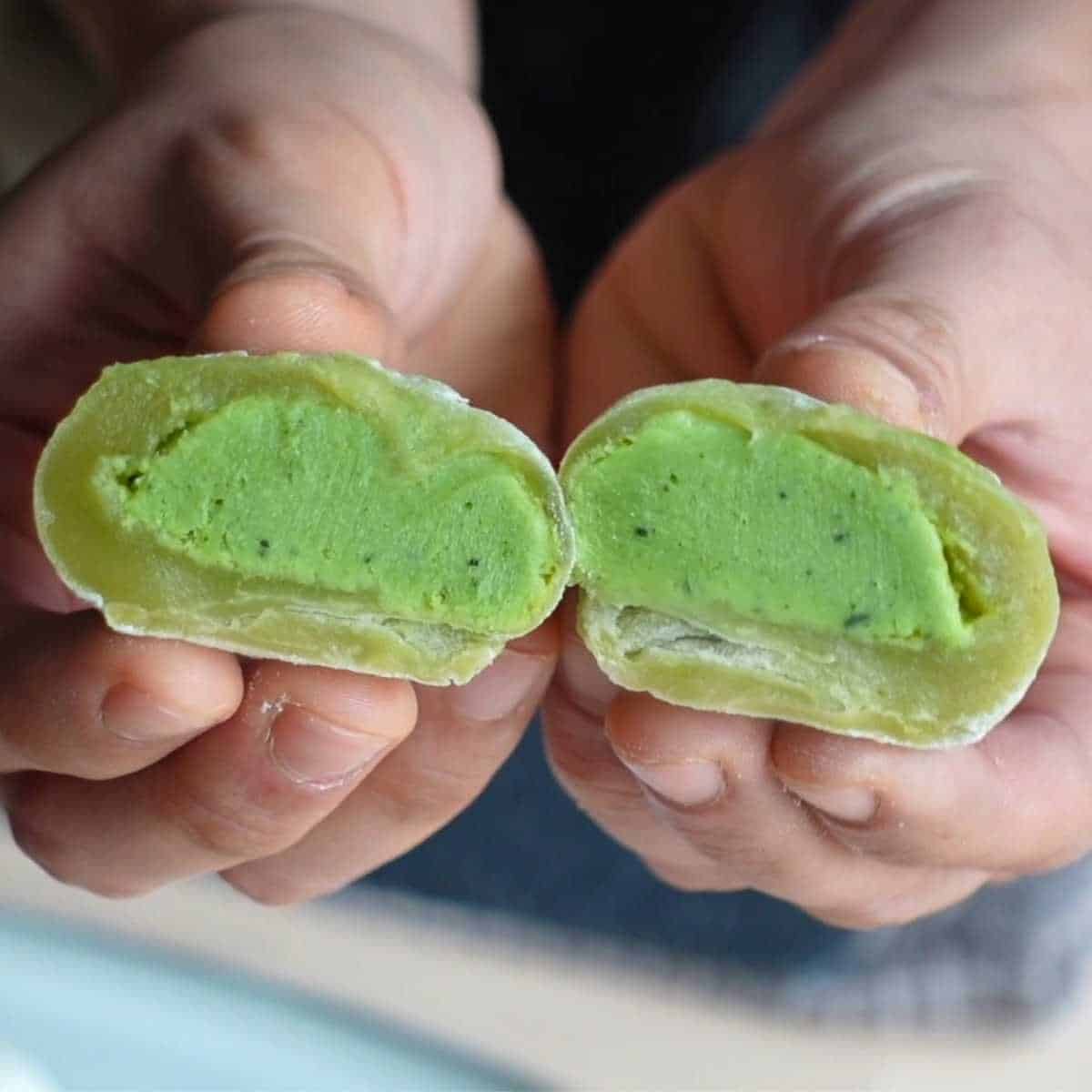
The traditional Japanese mochi recipe might sound loaded with gluten, but it’s not. Despite its name, glutinous rice is actually gluten-free, like all other rice.
Mochi Taste
These plain Japanese glutinous rice cakes are reminiscent of neutral-flavoured gummy snacks. The mochi dough tastes like marshmallows with subtle, sweet, and starchy undertones. While the rice bun doesn’t have much flavour on its own, the texture sets it apart and keeps people clamouring for more.
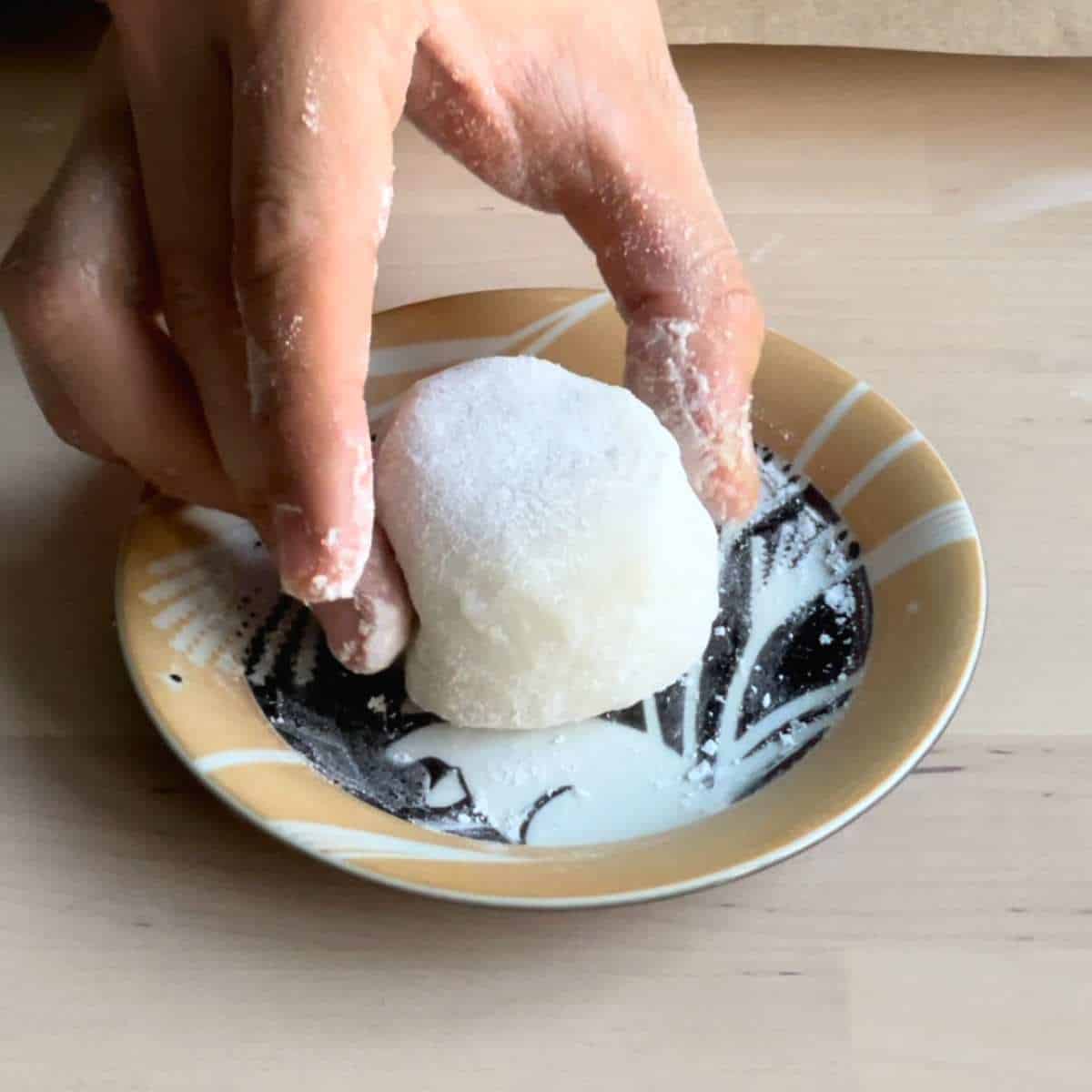
Of course, some experienced chefs successfully incorporate subtle flavours into the dough. Herbs work well in savoury variations, while sweeteners and matcha add a little pop to the sweet versions. However, most Asian desserts’ flavour comes from fillings, dips, and sauces.
Ingredients to make Mochi
One of the best parts about our microwave mochi recipe is that it requires few ingredients and allows some substitutions. If you’re not set on making the traditional variety, you can experiment to develop a custom creation.
Glutinous Rice Flour
Our recipe’s foundation uses regular glutinous rice flour rather than Japanese Mochiko.
Although Japanese glutinous rice flour provides the unique texture and subtle flavours we love, it's harder to find and more expensive. It’s made from short-grain rice kernels cooked, dehydrated, and milled into flour. Two types are available: a coarse-grain (Shiratamako) and a fine-grain (Mochiko). Most chefs have a preferred type, so it’s worthwhile to experiment.
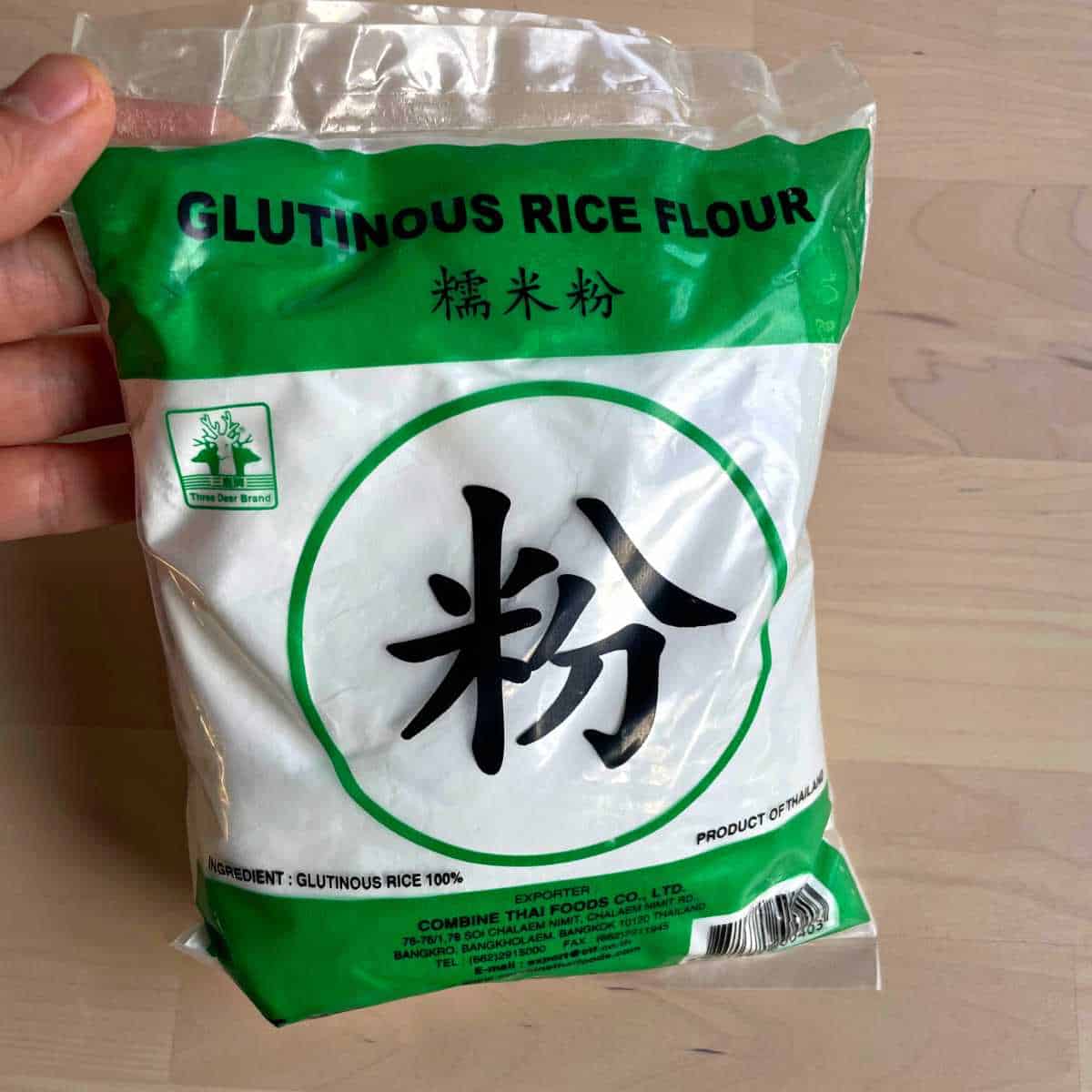
Sugar
Adding sugar to the mixture keeps the dough softer and longer. Using glutinous rice, you can add sugar during the kneading process. Mix the sugar and glutinous rice flour with the water when using a microwave. Quality granulated sugar or cane sugar is the most common, but confectioner’s sugar makes a fun experiment.
If you don’t have sugar in your pantry, pick some up at the local grocery store or order it online.
Starch
This dough is sticky and messy, making it challenging to shape. To remedy that issue, use potato starch or cornstarch on the work surface. It doesn’t impact the taste or texture but makes the dough easier to handle.
Potato starch is the more common choice for this dish, readily available at most grocery stores. If you already have cornstarch in your pantry, don’t rush out to get potato starch.
Mochi fillings
Don't forget the mochi filling to round out your list of daifuku ingredients. The most common choice is sweet red bean paste, but you can try almost anything, including strawberry slices, raspberries, and dollops of ice cream.
Mochi Daifuku Cooking Tips
Before you dive in, these quick tips might make your life and the experience a lot easier.
- To reduce sticking, try washing your hands with cold water or liberally dusting them with starch before handling the dough.
- Use cooking utensils, like rubber spatulas, to handle the dough as much as possible.
- Be careful not to pull at the dough pieces because it exposes sticky surfaces and makes your job more challenging.
- Extracts and food colouring can add variety and aesthetic appeal to your daifuku. Start with a drop or two to avoid going too bold.
- Cookie cutters are excellent for shaping the dough, and you can even experiment with unique shapes.
- While preparing the dough, set the filling in the refrigerator to chill so that it’s easier to drop on, spread, and stick to the warm dough.
- A cookie sheet with a slight lip works well for the kneading and shaping steps because it contains the mess.
- Brush away excess starch before filling the treats because closing the bun is challenging.
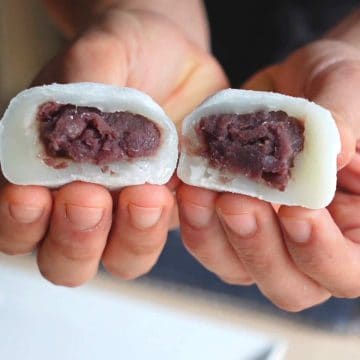
Daifuku Mochi Recipe (Microwave)
Video
Ingredients
- 100 g glutinous rice flour
- 25 g white sugar
- 150 ml hot water
- 2 tablespoon cornstarch or potato starch for dusting
- 200 g red bean paste (anko) or any other sweet filling of choice
Cooking Instructions
- Mix the glutinous rice flour with sugar in a medium, microwavable baking bowl. Then add the water until it is well combined.
- Loosely cover the bowl with plastic wrap and cook it for one minute on high heat.
- Remove the mixture from the microwave, use a wet rubber spatula to stir it. Then, recover and cook the mixture for another minute.
- Remove the mixture and stir again, checking for colour and consistency. It should be almost transparent and resemble dough. If not, microwave in 30-second increments, stirring in between.
- Spread the starch across the working surface and drop the dough on it, then dust it with more starch to make handling easier.
- Remove the dough and cut it into nine-centimetre circles. Fill each circle and pinch the opposite sides together until each daifuku mochi is completely sealed.
Recipe Notes
- Cookie cutters make it easy to create circles, but you can use cups, mugs, or bowls to get the size you desire. You can also play with alternate shapes and sizes.
- Anko is the most common filling used in a daifuku mochi recipe. Check out our easy home recipe on how to make sweet red bean paste.
- Red bean paste might be the most common filling, but other ingredients work well with it. Consider adding matcha, chocolate, or fruit.
- Using glutinous rice flour instead of glutinous rice only slightly alters the taste and texture, but significantly lessens prep and cooking time.
- The recipe for glutinous rice flour doesn’t require boiling and draining, but might involve more mixing to get the desired consistency.
- Serve the mochi treats immediately or store them in an airtight container for up to two days.
Nutrition
Calories have been calculated using an online calculator. Nutritional information offered on Honest Food Talks is for general information purposes and is only a rough estimate.
Make mochi without rice flour
Glutinous rice or glutinous rice flour are the only ingredients that deliver the desired texture and flavour. While you can try to substitute it, we don't recommend replacing it entirely as the recipe will not work. However, you can experiment with adding different types of flour to change the texture of the dough.
Tapioca starch will add chewiness to your dessert. Potato starch and cornstarch will add more of a resistant bite. However, it won't get stretchy or chewy. We haven't tried Arrowroot powder ourselves, but it is commonly used as a thickening agent and a substitute for glutinous rice flour.
You might have to experiment with water ratios and cook times to achieve the desired consistency. See here for more glutinous rice flour substitutes.
Unfortunately, regular flour doesn’t fare well for this Japanese sweet. It doesn’t develop the right consistency, so you don’t get the sticky, chewy bun that defines this Asian treat.
It’s tempting to substitute rice flour into the mochi recipe, but you’ll be disappointed by the outcome. Rice flour is a common gluten-free flour substitute for baking, but it’s processed differently and doesn’t get as stretchy or chewy as glutinous rice flour.
How to make mochi by steaming
Using a steamer is faster than the traditional method but takes more time than microwaving it. This method works best with glutinous rice flour because substitutes might not set properly with steam.
- Mix glutinous rice flour and water in a bowl that can handle high heat until it forms a soft, pliable dough.
- Bring water to a boil in the steamer before turning it down to a simmer.
- Set the dough bowl in the steam so that there is a gap between the bottom and the water’s surface.
- Cook the dough in the steamer for 15 to 20 minutes on medium to low heat.
- Remove from heat and scoop the hot dough into another pot set over medium heat.
- Gradually add the sugar, mixing thoroughly until it dissolves into the dough.
- Turn the dough onto a work surface covered with starch and drizzle more over the top.
- Cut the dough into pieces, add the filling and shape.
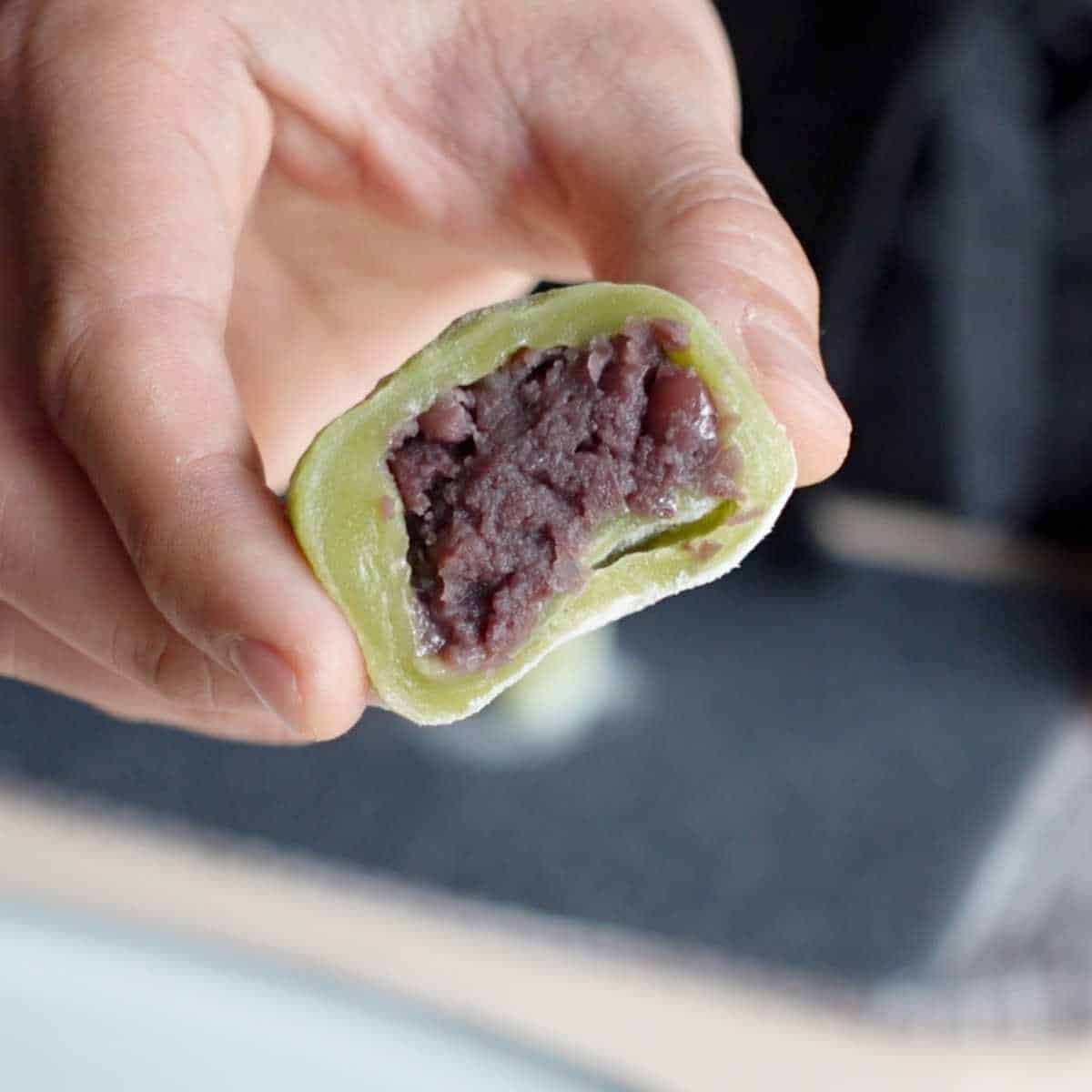
Daifuku vs. Mochi
Daifuku usually has a sweet filling, while mochi can be plain with no filling. However, nowadays, both types of glutinous rice cakes can come with some sort of filling. This is usually Anko, a sweet red bean paste.
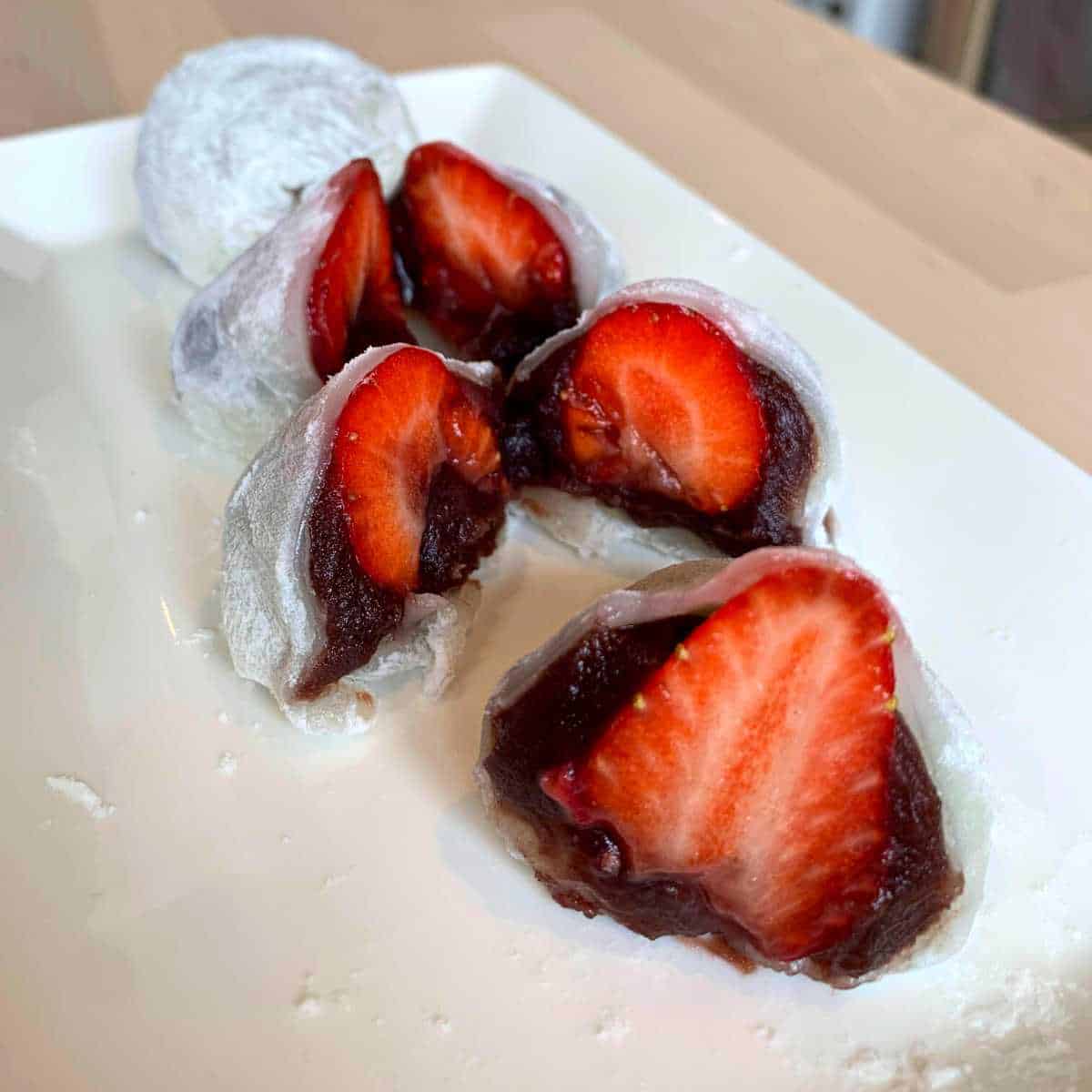
This distinction is essential because these rice cakes don’t always become desserts. Though much of the Western world views them as dessert, in Japan, the famous rice cakes can quickly become a savoury snack instead.
Another distinction is that mochi is usually smaller in size than daifuku. Mochi can also come in different shapes such as round balls to long and rectangular logs. On the other hand, daifuku is usually round as it will have some sort of filling inside.
How is mochi traditionally made?
Mochitsuki, the traditional method for making mochi dough, is a time-intensive process that doubles as a ritual ceremony. Crafting the dough requires skill, patience, and perseverance. Usually, a group of family members or friends works together to prepare it.
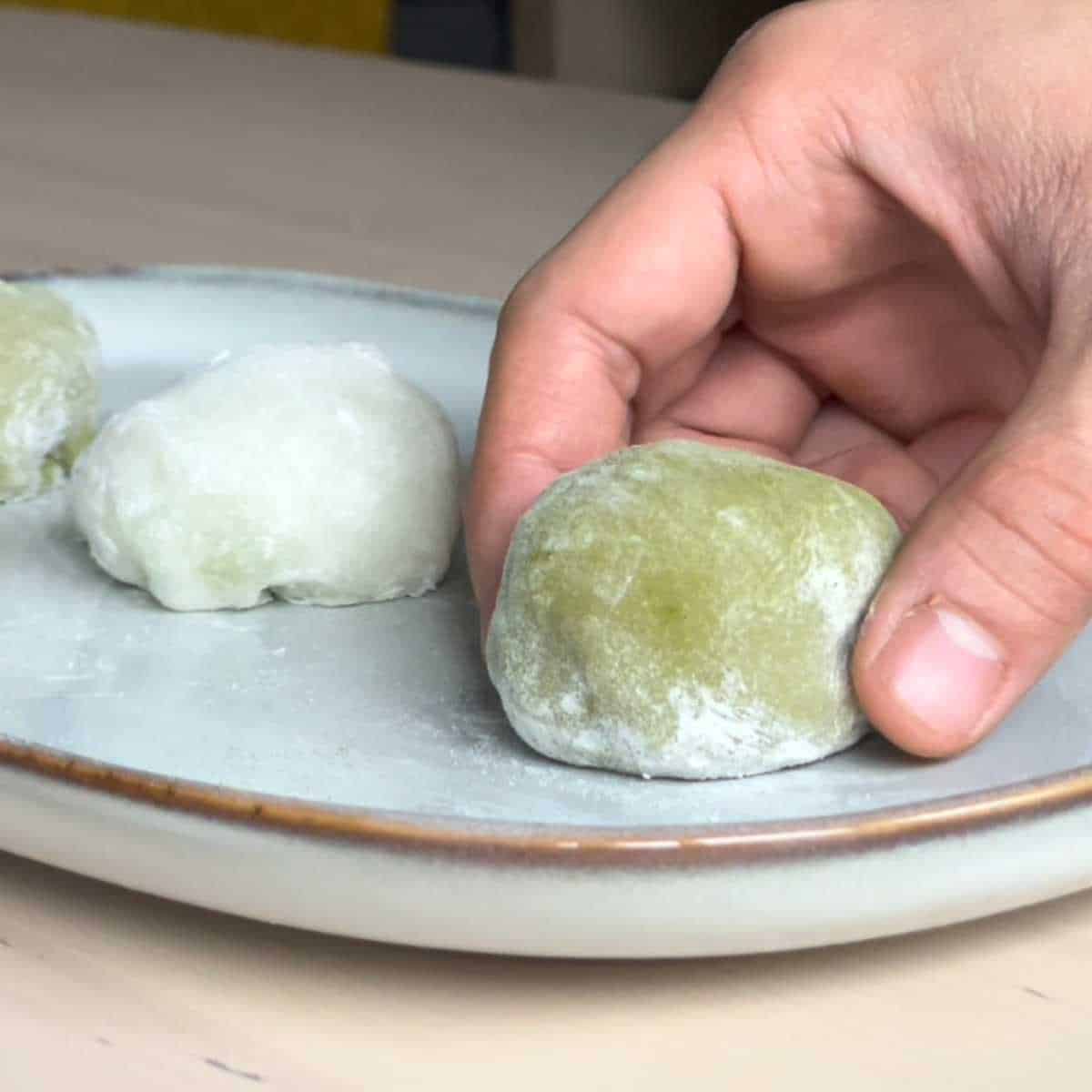
A traditional Japanese mochi recipe will begin with washing the rice and soaking it overnight. The rice goes into a special basket in the morning over boiling water. The soft, steamed rice goes into a mortar where somebody kneads it into a hot dough. Then, the fun begins.
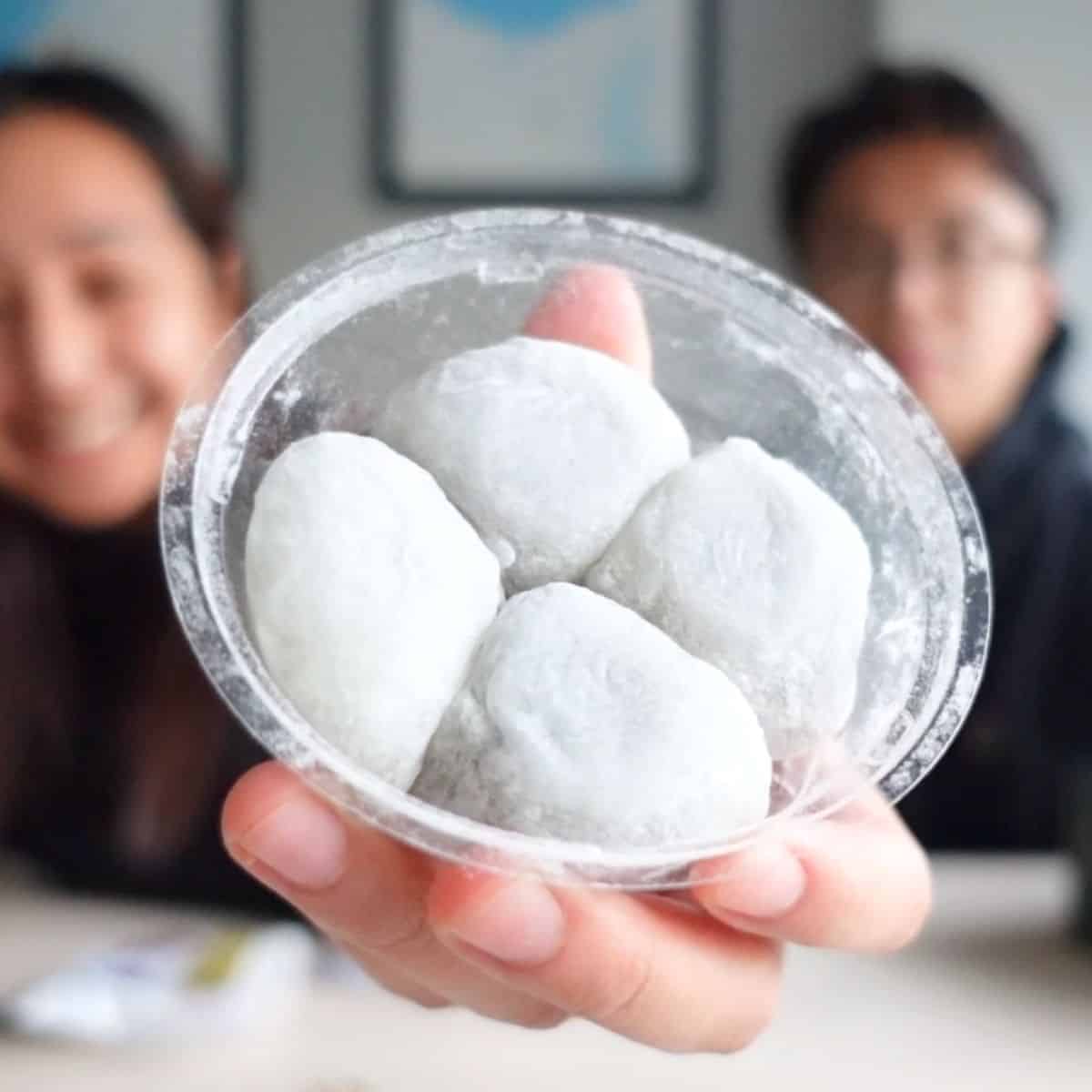
The pounding phase is crucial and takes at least two people working together. One person, the tsuki-te, uses a wooden mallet to pound the rice. The other person, the kaeshi-te, adds hot water and manipulates the dough so it doesn’t stick.
Mochi dough is heavy and hot, but the team needs to work fast because it hardens as it cools. Plus, the pounding process can be dangerous, requiring partners to communicate to avoid injury and churn out a smooth, consistent dough.
The final step is shaping the dough. It’s dropped onto a lightly floured surface to make it easier to handle the sticky dough. This is also the time for adding flavours, like red bean paste, herbs, and ice cream.
Mochi from glutinous rice (traditional recipe)
Like we described, traditional recipes use glutinous rice to make mochi dough. Whether the rice is boiled, steamed, or microwaved, it must be cooked enough to create the desired sticky texture for success.
If you're using glutinous rice, you can still use modern kitchen appliances to help make the process easier.
A rice cooker or steamer and a stand mixer make an excellent dough in less time and with less manpower involved. Instead of two or more people, a single chef can whip up a batch of daifuku.
- Rinse the glutinous rice and soak it for at least 15 minutes.
- Cook the glutinous rice on the stovetop or use a rice cooker, steamer, or instant pot.
- Knead the cooked glutinous rice for about three minutes with a dough hook on a professional stand mixer. Scrape the sides with a rubber spatula as needed.
- Change the dough hook to a flat beater to “pound” the dough for up to two minutes, breaking at 30-second intervals to scrape the sides.
- When the dough is smooth with no obvious rice granules turn out onto a starched workspace. Dust the top with more starch to prevent sticking.
- Roll, mould and fill the daifuku dough as desired.
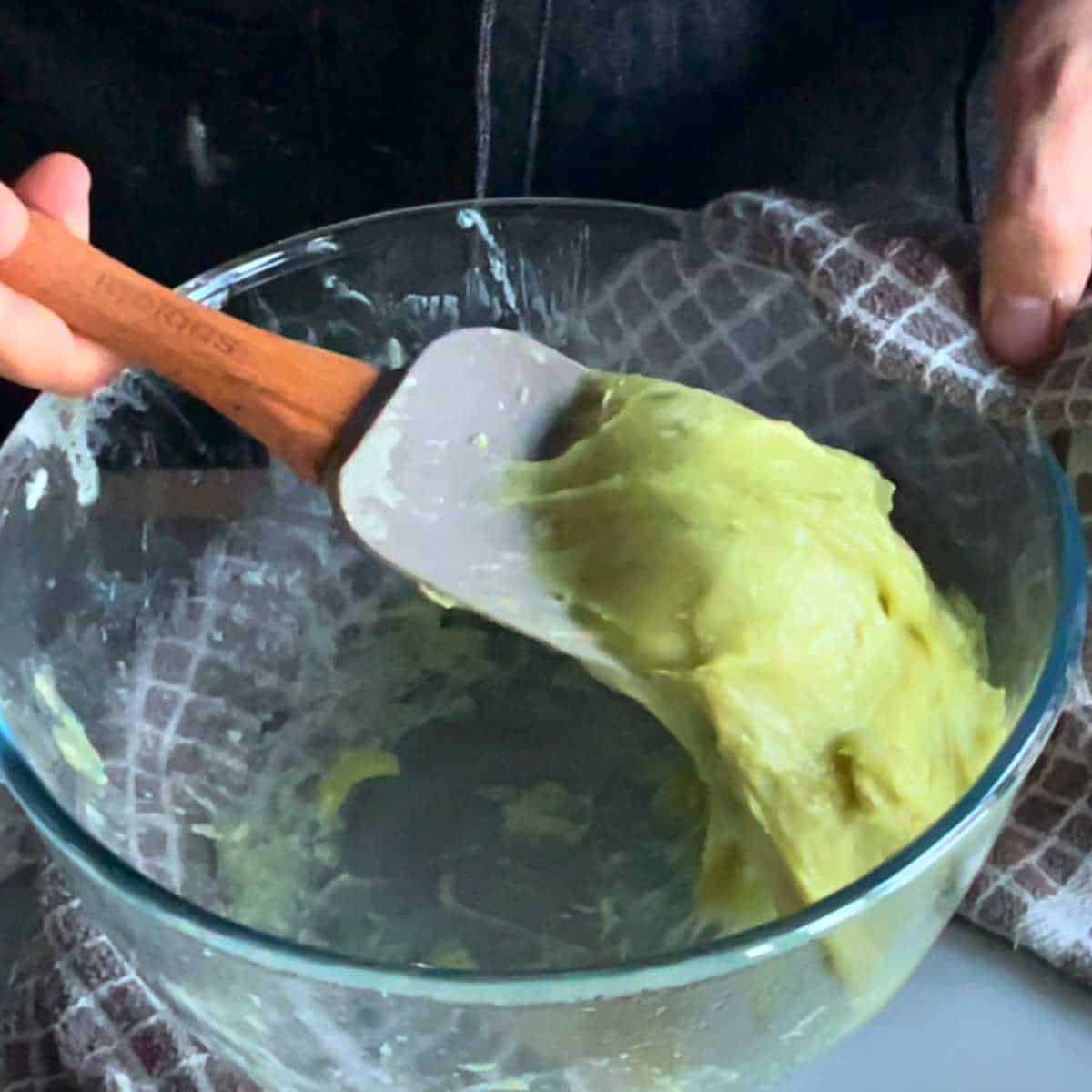
Variations
One of the best things about this neat little Japanese treat is its versatility. You can make it sweet or savoury and alter how you serve it.
If you’re looking for an alternate take on the traditional Japanese glutinous rice cakes, try one of these variations:
If you like these recipe ideas but don’t have time for them now, save them on Pinterest and try them later.
This Japanese treat is versatile and easy to customise for any setting. Altering your base between glutinous rice, glutinous rice flour, or set starches like tapioca or potato can all yield a fabulous dessert. You can also sweeten them with your favourite fruits, pastes, or ice cream.
Do you know somebody who would love to make this mochi recipe? Share the article with them now.
Are you looking for more classic and trendy Asian desserts to try? Follow us on Instagram @honestfoodtalks to discover the wonderful gastronomic world of Asian cuisine!

Leave a Reply